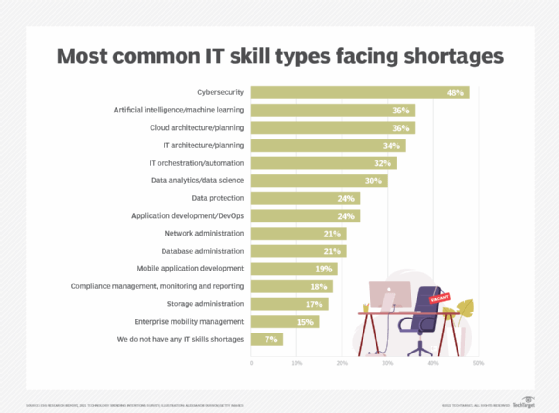A lack of skilled employees can hurt business initiatives. To solve this IT skills gap will take commitments to meeting employee demands and dedication to learning.
As the IT industry evolves, pushed by transitions to the cloud and the adoption of AI and then further accelerated by the pandemic, organizations face a serious problem finding qualified staff to fill these opening roles.
This IT skills shortage, or gap, presents an opportunity for both employers and employees: for the former, to improve business initiatives and company diversity, and for the latter, to improve their career. The pathway to achieving these goals branches in several directions.
And while there is no single path for everyone to follow, there are broad steps everyone can take to close this gap.
The IT skills shortage
An IT skills shortage is a gap between the skills an employer needs and the skills its employees have. For the IT industry, this is exacerbated by ever-evolving technology and trends.
For example, research from Enterprise Strategy Group’s “2021 Technology Spending Intentions Survey” shows a push to secure environments against increasing cybersecurity threats has made these skills the most sought after — and hardest to find.

Other top areas include cloud and IT orchestration and automation. Reducing this skills shortage will take both individual and company action.
Degrees vs. certifications vs. practical experience
For individuals, one way to improve their appeal to prospective employers is through certifications. The Linux Foundation’s 2021 “Open Source Jobs Report” stated that 88% of hiring managers prioritize hiring certified professionals, a jump up from 57% in 2020.
“I think it’s and, not or,” said Clyde Seepersad, senior vice president and general manager of training and certification at The Linux Foundation, of the degree vs. certification debate. “If you can find somebody with an IT degree and get them certified in technology, that’s great. But, by the same token, if you have somebody that does not have a traditional background, [but] can demonstrate the skills, you’re happy to give that person a try.”
In part, this jump can be attributed to the shift from multiple choice exams for certifications to performance-based testing. “I think the growth of performance-based testing has led to this sort of renewed acceptance and, in fact, demand for more IT certifications,” Seepersad said. Today, there are a slew of available IT certifications, covering not just different topics, but also different levels of IT knowledge. However, certifications are not the only way for a job candidate to increase their appeal.
“If you’re more on the developer side, pick some projects you like and start writing code. Even if it’s just a patch for a bug,” Seepersad said. “GitHub is the new resume. If you can show that you’re active, and that you’re engaged, that’s going to create a lot of credibility for your piece.”
This advice is not only great for developers, but for everyone, as the cloud inches closer to its peak. “With a cloud architect, it’s being able to have demonstrable experience, and [have] stood up a cloud footprint,” said Doug Cahill, vice president of analyst services and senior analyst at ESG. “That either you’ve helped an organization go through a cloud transformation, or you’ve worked in an organization that has done net-new development of a cloud application. You can point to that, and you can speak to the project.”
DevOps and the cloud create skills demand
Per the “Open Source Jobs Report,” 88% of professionals report using DevOps practices — an increase from 58% in 2018 and 75% in 2019. This growth indicates not just a push for CI/CD, but for the cloud, as well. DevOps and cloud operations go hand-in-hand, which means cloud computing is not only cementing itself as a staple, but that it still has room to grow as DevOps does. Figure 1 supports this theory further, showing the category “cloud architecture/planning” as tied for the second most common area of skills shortage.
“All the top areas of skills represent the most strategic IT initiatives,” Cahill said of the research presented in the ESG report. IT leaders indicated a drive to use more cloud services to take advantage of cybersecurity and analytics. ” … And that’s why they show up as the top areas of skill shortage — because that’s where organizations need to fund the most [to] move those initiatives along.”
For individuals, this requires commitment to not just gaining cloud skills and knowledge of staple technologies like Kubernetes, but dedicating themselves to lifelong learning.
“The two pieces of advice I give to everybody is find a way to start now, even if it’s small, even if it’s in a private, free hosted account, at one of the providers,” Seepersad said. “And the second is commit to the lifelong learning that’s going to be required.”
The IT industry’s evolution can move fast, and it’s all additive. For an IT operations professional, this can mean learning the latest stack of DevOps technology and tools, such as containers, then Kubernetes, then Prometheus and then FluentD. “So [there’s] this idea [that] you can never rest on your laurels because there’s always going to be the next thing that makes it cheaper, better, faster [or] more secure,” Seepersad said.
For example, the “Open Source Jobs Report” detailed that from 2019 to 2021, there was a 455% increase in the demand for a Kubernetes certification. And while it is unrealistic to expect this level of growth to hold steady, there is also no reason to expect another technology to present itself as a more efficient method, Seepersad said. “The demand for that skill set we see continuing to build as people get past the first wave of adoption with new stuff.”
A shift in power
Companies now find themselves in a position where they must market themselves to employees. As an applicant writes a cover letter and resume to meet a job role’s requirements, a company must change what it offers to meet candidates’ current demands.
The “Open Source Jobs Report” showed that in 2021, this means not just meeting the top demand for increased salaries — 48% wanted this — but also meeting the next top demand: increased training opportunities to meet the 35% of professionals who want to improve their skills.
This can take many forms. For example, companies can establish mentorship programs and in-house training programs, or support employees who wish to take certification courses.
Another way to attract candidates is to develop a technology roadmap that uses the latest cloud-native technologies, Cahill explained. “People want to make sure they’re working on the latest and greatest tech. That’s how they stay current. That’s how they’re going to be more marketable to what’s interesting to them personally.” Whatever the area of the shortage is, ESG’s research has found that it’s important to prospective employees that this area is a funding priority — and that the encompassing culture is taken seriously.
As companies see a larger talent pool thanks to the ramifications of the pandemic, they are also seeing a shift in power dynamics. In 2021, 66% of professionals from the “Open Source Jobs Report” said it would be easy to find a new job if they wanted to, as opposed to 55% in 2018 and 41% in 2020.
Meanwhile, 92% of hiring managers reported difficulty finding sufficient talent with open source skills. “I think, as an individual, it’s never been a better time to invest in yourself as a career, because this is not a fad,” Seepersad said.
This power is not limited to just what an employee wants out of their specific role, but extends to what they want to see from a company as a whole.
A push for diversity
The pandemic has transformed the way we work. The days spent in the office working a traditional 9-5 are gone. While some lament the loss of chatting with their coworkers face-to-face by the coffee machine, this transition to remote work offers more value to the individual and the company.
The individual worker might reap the rewards of flexible work locations — eliminated or reduced commute and the other personal benefits one garners working remotely — while companies must trust their employees can do their jobs from anywhere. And this newfound trust is helping close the skills gap by opening the talent pool.
“So you’re not just looking in the Bay Area, Boston, Austin and Bangalore, you’re trying to find talent wherever you can find it, because — it turns out — you actually have a higher level of confidence now that people can be productive, even if they’re not on a primary campus,” Seepersad said. “And I think that’s feeding into a broader variety of these recruitment and training strategies than what we’ve seen in the past.”
While the majority of diversity initiatives do not satisfy workers’ expectations yet, an Anywhere Operations model helps companies meet this demand. Diversity in the workplace is not limited to race and gender, but includes many other aspects, such as education and life experiences. To expand the educational backgrounds at a company can mean looking outside of traditional requirements for jobs — for example, taking into account practical experience and certifications rather than just degrees.
“When you’re trying to increase the diversity of your workforce, at the same time that you have a critical skill shortage, is a beautiful opportunity to try different things than what you’ve done before,” Seepersad said. Instead of hiring from the typical talent pools from the major tech hubs, organizations should expand their searches outside these location — and even academic — restraints, looking to people who are competing in hackathons, contributing to GitHub pages and completing specialized certifications.
As hiring candidates with varying educational backgrounds will bring different skills to an organization, hiring candidates with diverse life experiences will also bring new perspectives.
“Part of the value of diversity, in addition to it just being the right thing to do, is you’re going to get people from different backgrounds, different perspectives,” Cahill said. Diversity in IT, and the workplace in general, is about more than just team makeup. For example, when it comes to cybersecurity, “you’re going to have an increase in your chances of detecting and preventing attacks, because you can have a diversity of perspective. And so, in addition to ethnic and gender diversity, there’s also … background and life experience diversity. That’s a value.”
As negative as a skills shortage is, it also presents plenty of opportunities for positive growth. Technology never remains the same and neither should the people and companies behind it, which could mean individuals buckling down and learning new skills as well as IT organizations working to create a diverse workplace.
Source:
Source: TECHTARGET


